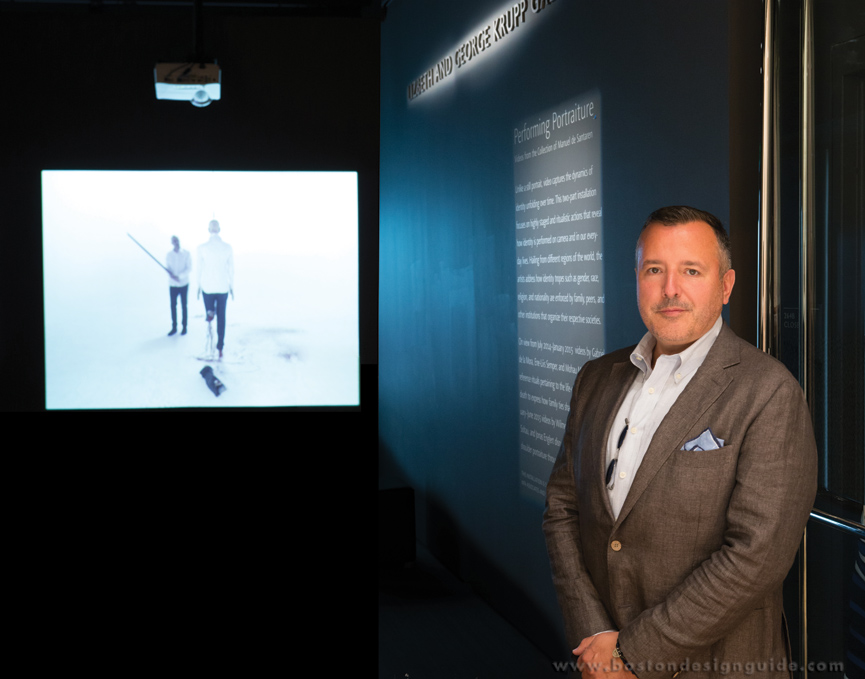August 6, 2014 | Sandy Giardi
Looking for a great way to beat the heat? Take a break from the rays, and soak up a little culture instead. We highly recommend lingering in the Linde Family Wing for Contemporary Art at the Museum of Fine Arts, Boston, and seeking out “Performing Portraiture: Video from the Collection of Manuel de Santaren,” a thought-provoking new exhibition in the Krupp Gallery.
In this year’s printed edition of Boston Design Guide (due out this month!), we feature acclaimed Boston interior designer and avid video art collector Manuel de Santaren. To prepare for the issue, we had the unique opportunity to meet up with de Santaren and experience three of the groundbreaking works in his 200-piece collection, generously on loan to the MFA. These installations, on view through January 2015, comprise Part I of the Krupp Gallery’s exhibition, and will be replaced by three more works, Part II of the series, from January to June of 2015.

photo by Roger Pelissier
What is it about video art that speaks to de Santaren? He loves that there is no speculation. “I love all ART, but when it comes to the past we are mostly speculating as to what [the artists] were thinking, and we don’t have the ability to communicate with them verbally. With contemporary artists, if you’re part of the discussion, you do get to meet them, speak to them and hear what they think. That puts the work into a whole other context for me.”
De Santaren knows every one of the artists whose work is on display in the gallery, which gives the incisive pieces yet another layer of meaning for the collector. But you don’t have to have a relationship with the artist to engage and be moved by the galvanizing works.
In Mexican born artist Gabriel de la Mora’s two-channel video 39-GMC-23.sept.2007 (pictured below behind de Santaren), the staged work represents the artist himself in piñata form, destroying the Mexican cliché just as surely as every blow dismantles his suspended likeness. The haunting, highly visual display explores issues of identity and family roots. Assistant Curator of Contemporary Art & MFA Programs Liz Munsell explains that it was conceived on de la Mora’s 39th birthday, “commemorating the age in which his father, also named Gabriel de la Mora, left the priesthood to have a family.” The work marks a new beginning for the artist, forcefully—and finally—putting to rest a period of intensive research on the part of the artist to understand his confounding late father.

Artwork pictured: Gabriel de la Mora, 39-GMC-23.sept.2007, 2007, two-channel video (color, sound), 20 minutes, 12 seconds. Courtesy the artist and Sicardi Gallery; photo by Roger Pelissier
Ene-Liis Semper of Estonia also addresses familial and societal roles, subverting the typical function of women as the caregiver for the next generation in the work Oasis, 1999. In this single channel video, unveiled after the birth of their first child, her partner performs a “planting” for the camera, in which the connection between body and nature is explored. Semper utilizes her own body as a tool in Oasis and is “force-fed” the role of nurturer. The unsettling video also references “household chores such as gardening” in its content, says Munsell, responsibilities stereotypically thought of as “women’s work.”

Artwork pictured: Ene-Liis Semper, Oasis, 1999, single channel video (color, sound), 3 minutes, 18 seconds. Courtesy of the artist and Galerie Anita Beckers; photo by Roger Pelissier
A third, mesmerizing work by Mohau Modisakeng titled Inzilo, 2013, completes the current exhibition. The riveting, four-minute video continues the conversation of violence and political disparity in post-apartheid South Africa. It is named for and references the Zulu custom in which a widow or widower mourns the death of their spouse for a period of time by wearing black. Modisakeng himself is portrayed in the installation, cloaked in black, peeling his garment bit by bit to reveal his skin underneath. By making what is typically a private ritual public, the artist conveys that South Africa has yet to recover from its history and that it too is in a state of mourning.
View this work as well as a slideshow of the others on the MFA Website.


Add new comment